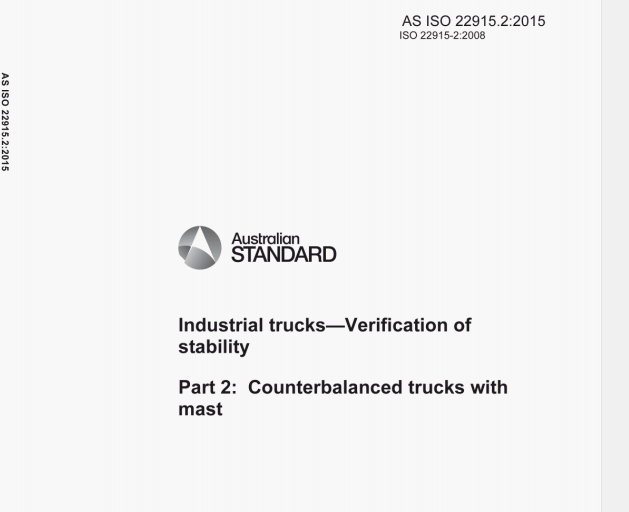AS ISO 22915.2:2015 pdf – Industrial trucks- Verification of stability Part 2: Counter balanced trucks with mast.
4.2.2 Tests I and 2
The truck shall be positioned on the tilt table so that its load axle, C—C, is parallel to the tilt axis, X—Y, of the tilt
table. See Table 1.
4.2.3 Tests 3 and 4
The truck shall be positioned on the tilt table in a turning position with the line, M—N, parallel to the tilt axis, X—Y, of the tilt table.
As shown in Table 1, the steered wheel nearest to the tilt axis shall be parallel to X—Y. Point M is defined as follows.
a) For trucks having an articulating steer axle: point M shall be the projection on the tilt table of the intersection of the longitudinal centre-plane, A—A, of the truck with the axis of this axle.
b) For trucks steered by a single wheel: point M shall be the centre point of the tread contact area between the steered wheel and the tilt table surface.
c) For trucks steered by twin wheels: point M shall be the centre point of the tread contact area between the steered wheel closest to the tilt axis. X—Y, of the tilt table and the tilt-table surface.
d) For trucks having wheels for steering not connected by a common axle, but that are arranged to articulate approximately about the longitudinal centre-plane of the truck: point M shall be the projection on the tilt table of the intersection of the longitudinal centre-plane of the truck, A—A, with the steer axle B—B connecting the vertical turning axis of the steer wheels.
As shown in Table 1, point N is defined as the centre point of the area of contact between the tilt table surface and the load wheel nearest to the tilt axis.
4.3 Datum point positions
Test 1 shall be conducted with the horizontal position of the load datum point. E, unchanged when elevated from its lowered position as shown in Figure 2.
With the prescribed test load, set the mast vertical and then elevate to approximately 300 mm above the tilt table, With the shank of the front face of the fork arm set vertical, establish point E, as shown In Figure 2 a), on the fork arms or fork carrier having a fixed relationship to the centre of gravity of the test load. E shall be used to provide a reference datum point, F, on the tilt table. When the mast is elevated, a new point, F1, on the tilt table may occur, as shown in Figure 2 b). This new point may be returned to the original location of F, as shown in Figure 2 c), by varying the tilt of the mast within the limits provided by the design of the truck.
AS ISO 22915.2:2015 pdf – Industrial trucks- Verification of stability Part 2: Counter balanced trucks with mast
